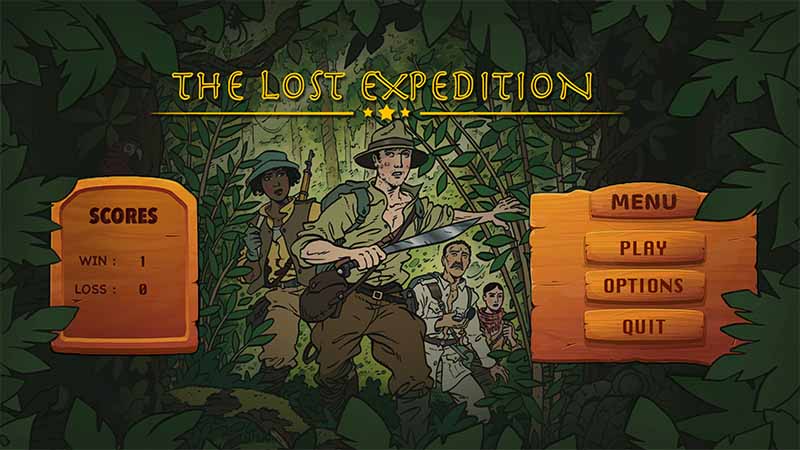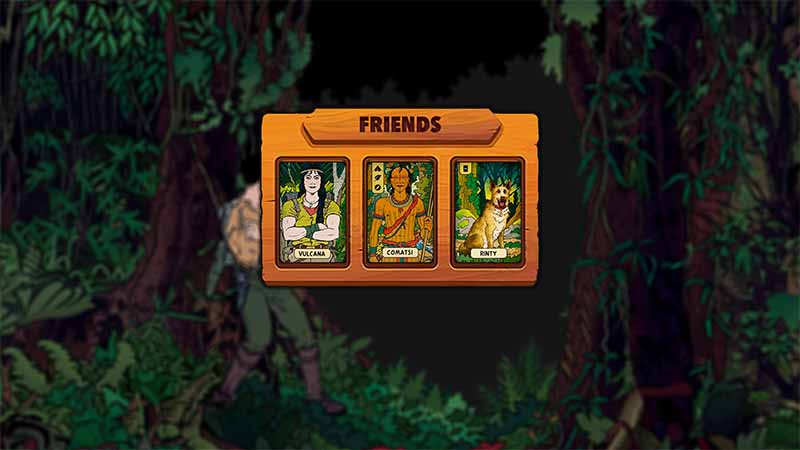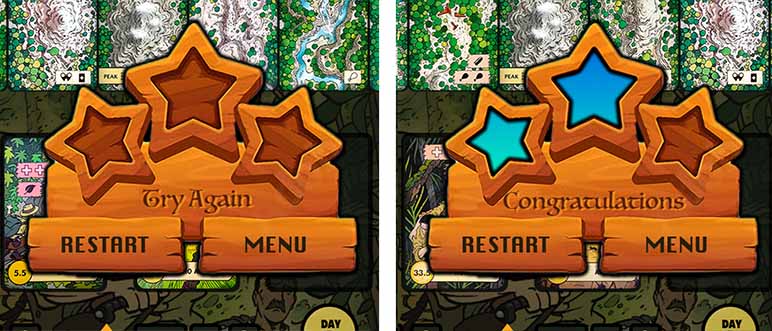Coding Board Game Using PyGame (The Lost Expedition)
Teaching my child the basics of game programming seemed like a fun and educational project. Little did I know it would turn into an exciting adventure, culminating in the creation of “The Lost Expedition” using PyGame. This blog post recounts my very first journey using pygame, highlighting the essential aspects of game development, including high-level structures, game loops, asset management, and modular design.
As I dove into the project, my primary goal was to make the learning process enjoyable and accessible. I started with the basics of PyGame, exploring how to create a window and draw simple shapes. From there, the project grew organically, evolving into a full-fledged board game.
High-Level Structure
The foundation of “The Lost Expedition” was built on a clear and organized structure. I divided the game into several key components:
- Initialization: Setting up the game window, loading assets, and initializing game variables.
- Game Loops: Managing multiple game states such as the main menu, gameplay, and game over screens.
- Asset Management: Loading and organizing images, sounds, and other resources.
- Design and Gameplay: Implementing game rules, player interactions, and the overall game flow.
- Modularity and Reusability: Writing reusable code to simplify future enhancements and maintenance.
Creating Multiple Game Loops
One of the challenges I faced was managing different game states efficiently. I tackled this by creating separate game loops for each state. This approach allowed us to keep the code clean and manageable. Here’s a simplified example of how I structured the game loops:
1
2
3
4
5
6
7
8
9
10
11
12
13
14
15
16
17
18
19
20
21
22
23
24
25
26
def main_menu():
while running_main_menu:
# Handle events
# Update menu
# Draw menu
def gameplay():
while running_gameplay:
# Handle events
# Update game state
# Draw game elements
def game_over():
while running_game_over:
# Handle events
# Update game over screen
# Draw game over screen
while game_running:
if current_state == 'main_menu':
main_menu()
elif current_state == 'gameplay':
gameplay()
elif current_state == 'game_over':
game_over()
Design and Gameplay
Designing the gameplay mechanics was where the project truly came to life. I brainstormed game rules, player actions, and objectives, translating them into code. I focused on creating a balanced and engaging experience, testing and refining the design iteratively.
Modularity and Reusability
To ensure the code was modular and reusable, I broke down the game logic into smaller, manageable functions and classes. This approach not only improved code readability but also made it easier to debug and extend the game.
Now, let’s go through each scene and various reusable contexts.
Internal Mechanics
Main Controller
I created a class for just initiating the main game loop, which then invokes the appropriate scene based on the current_state.Here is the actual code:
1
2
3
4
5
6
7
8
9
10
11
12
13
14
15
16
17
18
19
20
21
22
23
24
25
26
27
28
29
30
31
32
33
34
35
36
37
38
39
40
41
42
43
44
45
46
47
48
49
50
51
52
53
import pygame
from screens.main_menu import MainMenu
from screens.game_options import OptionMenu
from screens.game_play import GamePlay
from screens.game_start_option import GameStartOption
import json
from base import MAIN_MENU,OPTIONS_MENU,GAME,GAME_START
class TheLostExpedition:
def __init__(self) -> None:
pygame.init()
pygame.mixer.init()
display_info = pygame.display.Info()
self.W = display_info.current_w
self.H = display_info.current_h
self.flags = pygame.FULLSCREEN
self.clock = pygame.time.Clock()
self.screen = pygame.display.set_mode((self.W, self.H), self.flags)
self.current_state=[MAIN_MENU]
self.override_play_config()
self.game_states={}
self.game_states[MAIN_MENU]=MainMenu(self.W,self.H,self.clock,self.screen,self.current_state)
self.game_states[GAME_START]=GameStartOption(self.W,self.H,self.clock,self.screen,self.current_state)
self.game_states[OPTIONS_MENU]=OptionMenu(self.W,self.H,self.clock,self.screen,self.current_state)
self.game_states[GAME]=GamePlay(self.W,self.H,self.clock,self.screen,self.current_state)
def override_play_config(self):
# load and override play config
with open("game_data.json", "r") as file:
data = json.loads(file.read())
data["play_config"]={}
with open("game_data.json", "w") as file:
file.write(json.dumps(data))
def run_main_loop(self):
while True:
self.game_states[self.current_state[0]].run()
if __name__ == "__main__":
game=TheLostExpedition()
game.run_main_loop()
The run_main_loop is just having one loop to call run() from each state/scene based on current_state.
Scene 1: The Landing Page (Main Menu)
I initially designed this in photoshop then used as a background image. I kept the size very low so that it can be rendered fast. Then I used one Button class I found online. I modified it by adding more features such as click sound, adding name etc. Here is the code.
1
2
3
4
5
6
7
8
9
10
11
12
13
14
15
16
17
18
19
20
21
22
23
24
25
26
27
28
29
30
31
32
33
34
35
class Button:
def __init__(self, image, pos, text_input, font, base_color, hovering_color,name=""):
self.image = image
self.x_pos = pos[0]
self.y_pos = pos[1]
self.font = font
self.base_color, self.hovering_color = base_color, hovering_color
self.text_input = text_input
self.text = self.font.render(self.text_input, True, self.base_color)
if self.image is None:
self.image = self.text
self.rect = self.image.get_rect(center=(self.x_pos, self.y_pos))
self.text_rect = self.text.get_rect(center=(self.x_pos, self.y_pos))
self.click_sound=pygame.mixer.Sound(f"{ASSET}/audio/click.mp3")
self.click_sound.set_volume(0.5)
self.name=name
def update(self, screen):
if self.image is not None:
screen.blit(self.image, self.rect)
screen.blit(self.text, self.text_rect)
def checkForInput(self, position):
if position[0] in range(self.rect.left, self.rect.right) and position[1] in range(self.rect.top, self.rect.bottom):
self.click_sound.play()
return True
return False
def changeColor(self, position):
if position[0] in range(self.rect.left, self.rect.right) and position[1] in range(self.rect.top, self.rect.bottom):
self.text = self.font.render(
self.text_input, True, self.hovering_color)
else:
self.text = self.font.render(
self.text_input, True, self.base_color)
I also stored all the game data in one json file including the score, settings and temporary data. Here is the structure.
1
2
3
4
5
6
7
8
9
10
11
12
13
14
15
16
{
"scores": {
"win": 1,
"loss": 0
},
"options": {
"the_creature": true,
"the_lost_world": true,
"the_cursed_idol": true,
"the_fountain": true,
"the_mark": true,
"the_mountain": true,
"new_friends": true
},
"play_config": {}
}
I am not going to have the full code of all the scenes here. However, here is the code the main menu. I am calling init_background() and init_menu() from the __init__() function. Then from the game loop, I am invoking render() and event() function. The current_state is passed as a list so that the changes are propagated to all the classes (pass by reference).
1
2
3
4
5
6
7
8
9
10
11
12
13
14
15
16
17
18
19
20
21
22
23
24
25
26
27
28
29
30
31
32
33
34
35
36
37
38
39
40
41
42
43
44
45
46
47
48
49
50
51
52
53
54
55
56
57
58
59
60
61
62
63
64
65
66
67
68
69
70
71
72
73
74
75
76
77
78
79
80
81
82
83
84
85
86
87
88
89
90
91
92
93
94
95
96
97
98
99
import pygame
import sys
from base import MAIN_MENU,OPTIONS_MENU,GAME_START, ASSET, GAME
import json
from utils.ui import Button, get_font
class MainMenu:
def __init__(self,W,H,clock,screen,current_state) -> None:
self.W=W
self.H=H
self.clock=clock
self.screen=screen
self.current_state=current_state
self.sound = f"{ASSET}/audio/menu_audio.mp3"
self.refresh_options()
self.init_background()
self.init_menu()
def refresh_options(self):
with open("game_data.json","r") as file:
data=json.loads(file.read())
self.scores=data["scores"]
self.options=data["options"]
def init_background(self):
self.img_bg_game_menu = pygame.transform.scale(pygame.image.load(
f"{ASSET}/others/menu_bg.jpg").convert(), (self.W, self.H))
def load_score_data(self):
self.font_win = get_font("Krungthep", 36).render(str(self.scores["win"]), True, "#370b02")
self.rect_win = self.font_win.get_rect(center=(366, 668))
self.font_loss = get_font("Krungthep", 36).render(str(self.scores["loss"]), True, "#370b02")
self.rect_loss = self.font_loss.get_rect(center=(366, 740))
def init_menu(self):
self.start_button = Button(None, pos=(1647, 635), text_input="PLAY", font=get_font(
"Krungthep", 48), base_color="#5b1900", hovering_color="#360000")
self.options_button = Button(None, pos=(1647, 731), text_input="OPTIONS", font=get_font(
"Krungthep", 48), base_color="#5b1900", hovering_color="#360000")
self.quit_button = Button(None, pos=(1647, 836), text_input="QUIT", font=get_font(
"Krungthep", 48), base_color="#5b1900", hovering_color="#360000")
self.load_score_data()
def play_music(self, music_file):
pygame.mixer.music.stop()
pygame.mixer.music.load(music_file)
pygame.mixer.music.set_volume(0.5)
pygame.mixer.music.play(-1)
def render(self):
self.screen.blit(self.img_bg_game_menu, (0, 0))
self.screen.blit(self.font_win, self.rect_win)
self.screen.blit(self.font_loss, self.rect_loss)
for button in [self.start_button, self.options_button, self.quit_button]:
button.changeColor(self.MOUSE_POS)
button.update(self.screen)
def event(self):
for event in pygame.event.get():
if event.type == pygame.MOUSEBUTTONDOWN:
if self.start_button.checkForInput(self.MOUSE_POS):
if self.options["new_friends"] == True:
self.current_state[0]=GAME_START
else:
self.current_state[0]=GAME
if self.options_button.checkForInput(self.MOUSE_POS):
self.current_state[0]=OPTIONS_MENU
if self.quit_button.checkForInput(self.MOUSE_POS):
pygame.quit()
sys.exit()
if event.type == pygame.QUIT:
pygame.quit()
sys.exit()
elif event.type == pygame.KEYDOWN:
if event.key == pygame.K_o:
self.current_state[0]=OPTIONS_MENU
elif event.key == pygame.K_q:
pygame.quit()
sys.exit()
elif event.key == pygame.K_ESCAPE:
pygame.quit()
sys.exit()
def run(self):
self.refresh_options()
self.play_music(self.sound)
while self.current_state[0] == MAIN_MENU:
self.MOUSE_POS = pygame.mouse.get_pos()
self.render()
self.event()
pygame.display.flip()
self.clock.tick(60)
Scene 2: Game Settings
The Options takes to the OPTIONS_MENU. This is a static scene, except the check boxes. I have included all the available promo cards and expansions.
I created a new class named ToggleButton for implementing button with two states. This will be used in several more places in the game. The code is very similar to Button, however this does not show any text and have two images and a state to track which image to render.
1
2
3
4
5
6
7
8
9
10
11
12
13
14
15
16
17
18
19
20
21
22
23
24
25
26
27
28
29
30
31
32
33
class ToggleButton:
def __init__(self, image1, image2, pos, name=""):
self.image1 = image1
self.image2 = image2
self.pos = pos
self.state = True
self.name=name
self.set_image()
self.click_sound=pygame.mixer.Sound(f"{ASSET}/audio/click.mp3")
self.click_sound.set_volume(0.5)
def set_image(self):
if self.state == True:
self.image = self.image1
else:
self.image = self.image2
self.rect = self.image.get_rect(center=(self.pos[0], self.pos[1]))
def update(self, screen):
screen.blit(self.image, self.rect)
def checkForInput(self, position):
if position[0] in range(self.rect.left, self.rect.right) and position[1] in range(self.rect.top, self.rect.bottom):
self.click_sound.play()
return True
return False
def toggle(self):
self.state = not self.state
self.set_image()
return self.state
Scene 3: Game Start Options
When the New Friends, expansion is enable, we need to choose one of the three options for the friends. So I have created a scene for this as I didn’t want to clutter the actual GamePlay class. I used images from the game guide for the background, using generating AI in photoshop I have expanded the images to make it more interesting and full screen.
Here is the code in the MainMenu we saw earlier where the scene is activated when new_friends options is True.
1
2
3
4
5
6
if event.type == pygame.MOUSEBUTTONDOWN:
if self.start_button.checkForInput(self.MOUSE_POS):
if self.options["new_friends"] == True:
self.current_state[0]=GAME_START
else:
self.current_state[0]=GAME
Upon selecting a character, I am saving the data to the json file and not passing this as a parameter as this approach can be used for any other game.
Scene 4: Game Play
This is the most complicated part with ~800 lines of code. The game play has two main state, Day and Night. I have used two separate background color temperatures and music to bring more theme into the play.
The cards are the main part of the GamePlay. I have created a spite class named PlayingCards by extending the pygame.sprite.Sprite class. I loads the front and back image, deals and flips the card.
1
2
3
4
5
6
7
8
9
10
11
12
13
14
15
16
17
18
19
20
21
22
23
24
25
26
class PlayingCards(pygame.sprite.Sprite):
def __init__(self,id,image_path,back_img_name,pos) -> None:
super().__init__()
self.front = False
self.back_img = pygame.image.load(
f"{image_path}/{back_img_name}.png").convert_alpha()
self.front_img = pygame.image.load(
f"{image_path}/{id}.png").convert_alpha()
self.update()
self.rect = self.image.get_rect(center=pos)
def update(self) -> None:
if self.front == True:
self.image = self.front_img
else:
self.image = self.back_img
def deal(self):
self.front=True
def flip(self):
self.front = False
self.update()
Then I am loading all the cards (based on what expansion being selected in the option scene) into a Sprite Group, pygame.sprite.Group().
1
2
for card in self.cards:
self.playing_cards.add(PlayingCards(card,image_path="assets/cards_final",back_img_name="back",pos=(116, 202)))
One major feature here is the drag and drop. I have used MOUSEBUTTONUP, MOUSEMOTION and MOUSEBUTTONDOWN for this. On MOUSEBUTTONUP I am looking for collision between the mouse pos and all the cards then selecting the card.
1
2
3
4
5
6
7
8
9
10
11
12
def event_game_window(self):
for event in pygame.event.get():
if event.type == pygame.MOUSEBUTTONUP:
if event.button == 1:
self.event_game_window_mouse_up()
if event.type == pygame.MOUSEMOTION:
self.event_game_window_mouse_motion(event)
if event.type == pygame.MOUSEBUTTONDOWN:
if event.button == 1:
self.event_game_window_mouse_down(event)
On MOUSEMOTION I am moving the selected card based on the mouse position. All the cards are in a SpriteGroup here. Then on MOUSEBUTTONDOWN, I am simply resetting the currently active card so that it does not get move with the mouse position.
1
self.playing_cards.sprites()[self.active_card].rect.move_ip(event.rel)
In order to make the experience better, I am storing all the predefined position where a card can be placed in an array. Then during MOUSEBUTTONDOWN I am finding the closest spot and automatically moving the card there. This provides a magnet like experience where the cards are automatically pulled to the exact position. You can see this the game play video above.
Each card can be flipped by right click, unless they are in deck or in discard pile.
1
2
3
4
5
6
for i, s in enumerate(self.playing_cards.sprites()):
if s.rect.center not in [(116, 202), (1919, 204)] and s.rect.collidepoint(self.MOUSE_POS):
if s.front==False:
s.deal()
else:
s.flip()
All the leaders are loaded using another Sprite class named Leaders. Leaders have expertise and defeated attributes to keep track.
1
2
3
4
5
6
7
8
9
10
11
12
13
14
15
16
17
18
19
20
21
22
23
24
25
26
import pygame
class Leaders(pygame.sprite.Sprite):
IMAGE_PATH = "assets/leaders"
def __init__(self, name,pos,expertise) -> None:
super().__init__()
self.name=name
self.expertise=expertise
self.defeated = False
self.alive_img = pygame.image.load(
f"{Leaders.IMAGE_PATH}/{name}.png").convert_alpha()
self.defeated_img = pygame.image.load(
f"{Leaders.IMAGE_PATH}/{name}_defeated.png").convert_alpha()
self.update()
self.rect = self.image.get_rect(center=(pos[0], pos[1]))
def update(self) -> None:
if self.defeated == False:
self.image = self.alive_img
else:
self.image = self.defeated_img
def defeat(self):
self.defeated=True
Each leader has associated health which can be incremented or decremented. Same for the resources as well. I have created a map object to have all these stored. This helped to not create many variables and their associations.
1
2
3
4
5
6
7
8
9
10
11
12
13
14
15
16
17
18
19
20
21
22
23
24
25
26
27
28
29
30
31
32
33
34
35
36
37
38
39
40
41
42
43
44
45
46
47
48
49
self.game_state = {
"resource": {
"food": {
"actions": {
"inc": None,
"dec": None
},
"value": 3,
"txt_obj": {
"text": None,
"text_rect": None
}
},
"ammunition": {
...
}
},
"expertise": {
"friend": {
...
},
"compass": {
"actions": {
"inc": None,
"dec": None
},
"value": 0,
"txt_obj": {
"text": None,
"text_rect": None
},
"txt_obj_health": {
"text": None,
"text_rect": None
},
"health": 3,
"health_actions": {
"inc": None,
"dec": None
}
},
"leaf": {
...
},
"tent": {
...
}
}
}
Once clicked on Day/Night button, the background image and music will change. Below you can see the game playing using all the expansions and promo cards.
Once the end state has been detected, the result will be displayed. I am using Victory class to load various images based on the victory conditions.
1
2
3
4
5
6
7
8
9
10
11
12
13
14
15
16
17
18
19
20
21
22
23
24
25
26
27
28
29
30
class Victory(pygame.sprite.Sprite):
IMAGE_PATH = "assets/others"
def __init__(self,pos) -> None:
super().__init__()
self.win0 = pygame.image.load(
f"{Victory.IMAGE_PATH}/finish_win0.png").convert_alpha()
self.win1 = pygame.image.load(
f"{Victory.IMAGE_PATH}/finish_win1.png").convert_alpha()
self.win2 = pygame.image.load(
f"{Victory.IMAGE_PATH}/finish_win2.png").convert_alpha()
self.win3 = pygame.image.load(
f"{Victory.IMAGE_PATH}/finish_win3.png").convert_alpha()
self.update()
self.rect = self.image.get_rect(center=(pos[0], pos[1]))
def update(self,id:int=0) -> None:
if id == 0:
self.image = self.win0
elif id == 1:
self.image = self.win1
elif id == 2:
self.image = self.win2
else:
self.image = self.win3
Here is the example of Win and Loss.
Finally, the game loop is very small and optimized.
1
2
3
4
5
6
7
8
9
10
11
12
13
def run(self):
self.init_game_state()
self.play_music(self.day_sound)
self.active_card = None
self.move_meeple = None
while self.current_state[0] == GAME:
self.draw_background()
self.MOUSE_POS = pygame.mouse.get_pos()
self.render_game_window()
self.event_game_window()
pygame.display.flip()
self.clock.tick(60)
Conclusion
Creating “The Lost Expedition” was not only a rewarding experience but also a valuable learning journey for me. As a first-time PyGame user, I discovered the intricacies of game development, from managing game loops and assets to designing engaging gameplay mechanics. This project opened up a new world of possibilities, blending my passion for tabletop games with the power of digital technology.
Through this process, I gained a deeper appreciation for modularity and reusability in game development, which made the experience smoother and more efficient. Now that I’ve successfully created my first digital board game, I am excited to continue this journey. I plan to develop more digital versions of tabletop games, each offering a unique blend of traditional gameplay and modern interactivity.
The skills and knowledge I acquired while working on “The Lost Expedition” have laid a solid foundation for future projects. I’m eager to explore new ideas, refine my techniques, and bring more beloved board games into the digital realm. If you’re passionate about coding and gaming, I encourage you to dive into PyGame and start your own adventure in game development. Happy coding!





